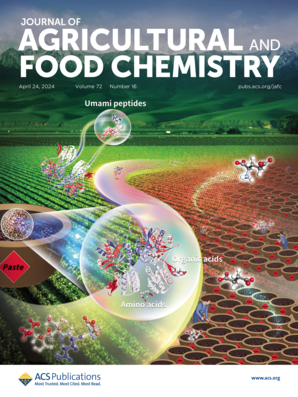OsVQ32-OsWRKY53模块通过抑制osprx30介导的ROS清除来调节水稻对白叶枯病的抗性
IF 5.7
1区 农林科学
Q1 AGRICULTURE, MULTIDISCIPLINARY
引用次数: 0
摘要
WRKY转录因子在调控植物免疫应答中发挥着重要作用。我们之前的研究表明,OsWRKY53通过降低细胞壁厚度对水稻抗白叶枯病产生负面影响。在这项研究中,我们确定了OsWRKY53和OsVQ32之间的物理相互作用,揭示了OsWRKY53作为OsMPK4-OsVQ32级联的下游组分。OsWRKY53可以直接结合OsPrx30的启动子,从而激活其表达。OsPrx30是一个负向影响水稻对白叶枯病抗性的基因。oswrky53过表达植株的过氧化物酶活性显著增加,过氧化氢含量显著降低,而在oswrky53突变体中观察到相反的效果。此外,我们发现OsVQ32和OsWRKY53之间的相互作用形成一个复合物,通过增强OsWRKY53的dna结合活性来抑制OsPrx30的转录。OsMPK4对OsVQ32的磷酸化进一步增强了这种抑制。总之,我们的研究结果表明,OsVQ32-OsWRKY53复合物调节OsPrx30的表达,通过抑制活性氧的清除来调节对细菌枯萎病的抗性。本文章由计算机程序翻译,如有差异,请以英文原文为准。

OsVQ32–OsWRKY53 Module Regulates Rice Resistance to Bacterial Blight by Suppressing OsPrx30-Mediated ROS Scavenging
WRKY transcription factors play crucial roles in regulating plant immune responses. Our previous research showed that OsWRKY53 negatively affects rice resistance to bacterial blight by reducing the thickness of the cell wall. In this study, we identified a physical interaction between the OsWRKY53 and the OsVQ32, revealing that the OsWRKY53 functions as a downstream component of the OsMPK4–OsVQ32 cascade. OsWRKY53 can directly bind to the promoter of OsPrx30, a gene that negatively affects rice resistance to bacterial blight, thereby activating its expression. OsWRKY53-overexpressing plants exhibited a significant increase in peroxidase activity and a decrease in hydrogen peroxide content, whereas the opposite effects were observed in the oswrky53 mutants. Furthermore, we found that the interaction between OsVQ32 and OsWRKY53 forms a complex that represses OsPrx30 transcription by enhancing the DNA-binding activity of OsWRKY53. OsVQ32 phosphorylation by the OsMPK4 further enhanced this suppression. In conclusion, our findings suggest that the OsVQ32–OsWRKY53 complex regulates the expression of OsPrx30, modulating resistance to bacterial blight by suppressing the scavenging of reactive oxygen species.
求助全文
通过发布文献求助,成功后即可免费获取论文全文。
去求助
来源期刊
CiteScore
9.90
自引率
8.20%
发文量
1375
审稿时长
2.3 months
期刊介绍:
The Journal of Agricultural and Food Chemistry publishes high-quality, cutting edge original research representing complete studies and research advances dealing with the chemistry and biochemistry of agriculture and food. The Journal also encourages papers with chemistry and/or biochemistry as a major component combined with biological/sensory/nutritional/toxicological evaluation related to agriculture and/or food.

 求助内容:
求助内容: 应助结果提醒方式:
应助结果提醒方式:


